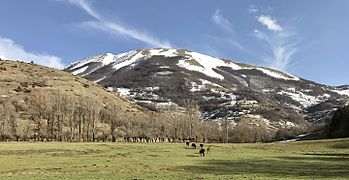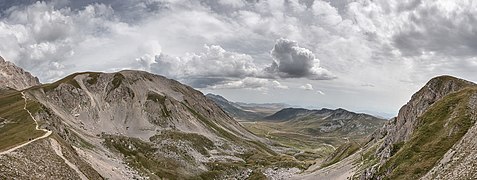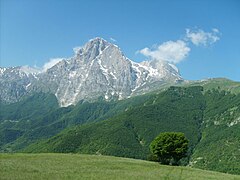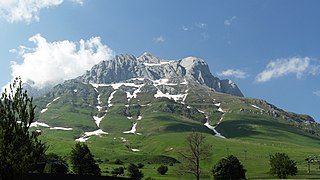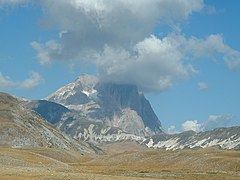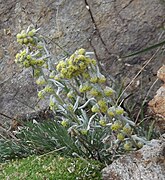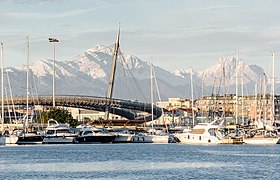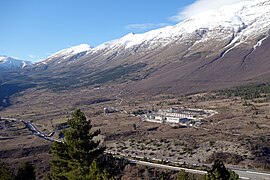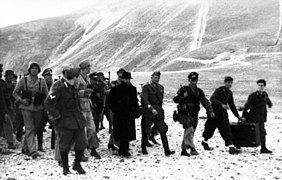Gran Sasso d'Italia
| Gran Sasso d'Italia | ||
|---|---|---|
|
The Gran Sasso massif from east to west, left of the center of the picture the Corno Grande, in the foreground the plateau Campo Imperatore |
||
| Highest peak | Corno Grande ( 2912 m slm ) | |
| location | Teramo , L'Aquila , Pescara , Abruzzo (Italy) provinces | |
| part of | Abruzzo Apennines | |
|
|
||
| Coordinates | 42 ° 28 ' N , 13 ° 33' E | |
| rock | Sedimentary rock | |
The Gran Sasso d'Italia (short Gran Sasso , Italian for "big stone Italy") is a mountain range on the border of the provinces of Teramo , Pescara and L'Aquila in the region of Abruzzo in Italy .
Surname
The Romans called him because of its central location on the Apennine Peninsula as Fiscellus Mons ( Latin navel-Berg ).
In the Middle Ages, the massif was called Monte Corno, based on the highest peak, the Corno Grande. According to the geographer Roberto Almagià , the name Gran Sasso d'Italia was not used by writers until the 17th century. It can be proven for the first time in a similar form in a poem by Francesco Zucchi di Montereale from 1636, which uses the name Sasso d'Italia . In a map of the Archdiocese of L'Aquila from the 18th century, both names, Monte Corno and Gran Sasso d'Italia, are used side by side for the first time.
From Pescara , the outlines of the Gran Sasso at dusk resemble those of a sleeping woman, which is why it is known as “ la bella addormentata ” - the sleeping beauty. A designation that is attributed to the poet Gabriele D'Annunzio , who came from Pescara .
geography
These highest mountains on the Apennine Peninsula, located roughly in the middle, form the westernmost and at the same time highest part of the Abruzzo Apennines . The highest peak of the Gran Sasso is the Corno Grande at 2,912 m. On its north side is the southernmost glacier in Europe , the Calderone Glacier ( Ghiacciaio del Calderone ). To the southeast, the strikingly shaped mountains formed in the Neogene merge into the 1,600 to 2,200 m high karst plateaus of Campo Imperatore .
Demarcation
The Gran Sasso massif is an east-west running in orographic sense about 50 kilometers long and up to 20 kilometers wide limestone massif . In the east and south-east near Popoli it is delimited by the Pescara valley from the Morrone and Majella groups . In the south and southwest it is the upper reaches of the Pescara, mutated from Popoli into Aterno, that delimits the massif. The Aterno valley, on the other hand, separates the Gran Sasso from the Velino and Sirente groups. In the west and north-west it is the valley of the Vomano that separates the Gran Sasso from the mountains of the Laga, while in the north the massif ends in the hilly landscape at Teramo . In the narrower alpine sense, the Gran Sasso massif includes all elevations that lie between the Passo delle Capanelle in the west and the passes Vado di Penne and Forca di Penne on the extreme eastern edge of the Campo Imperatore plateau. This is followed by the southern foothills of the massif, including Monte Fiore, Monte Cappucciata and Monte Picca, north of Popoli near Bussi sul Tirino .
structure
The Gran Sasso massif can be subdivided into three areas, western, central and eastern, which in turn consist of individual mountain ridges and mountain ranges.
Western area
South ridge - Monte Corvo - Pizzo d'Intermesoli
Forms the extreme western area of the massif from Passo della Campanelle ( 1300 m ) in the west to the saddle of Monte Aquila east of Monte Portella ( 2385 m ) in the east. The highest elevation of this ridge running from west to east, which merges almost seamlessly into the central area of Gran Sasso between Monte Portella and Monte Aquila, is the Pizzo Cefalone at 2533 m . North of the southern ridge are the two almost equally high mountain ranges Monte Corvo ( 2623 m ) and Pizzo d'Intersemoli ( 2635 m ). The two northern foothills are separated from each other by the Valle Venacquaro.
The southern ridge from Monte San Franco to Monte Portella was first fully climbed in August 1926 by five Italian mountaineers.
Central area
Corno Grande - Corno Piccolo
At the center of the central area is the 2912 m high western summit of Corno Grande, which is by far the highest elevation of the entire massif. The latter forms with the Corno Piccolo ( 2655 m ) the two subgroups of which the central area consists and to which two further elevations belong with the Primo Scrimone ( 2480 m ) and the Monte Aquila ( 2495 m ). The center of the central area is the western summit of the Corno Grande, around which the Corno Piccolo in the north, the central and eastern summit of the Corno Grande in the east, the Primo Scrimone in the west and the Monte Aquila in the south line up in a cross shape. The latter also forms the first elevation of the east ridge of the massif, which runs from here in a south-easterly direction.
Eastern area
Eastern ridge
The eastern ridge of the Gran Sasso massif extends over a length of about 20 km from the Vado di Corno 1924 m , a ridge cut at the height of the Corno Grande to the Vado di Sole, at the extreme eastern end of the massif. The ridge running from west to east reaches its highest point with the 2565 m high Monte Camicia. The plateau of Campo Imperatore lies along the south side of the ridge. Further elevations on the eastern ridge are from west to east the Monte Brancastello ( 2385 m ), Monte Infornace ( 2362 m ), Monte Prena ( 2561 m ) and the Monte Camicia. From the latter, the ridge runs in a south-easterly direction to the Vado di Sole pass ( 1621 m ), where the Campo Imperatore plateau ends. The eastern ridge was crossed for the first time in May 1927 by three Italian mountaineers.
climate
The proximity of the massif to the Adriatic (45 km) and the Tyrrhenian Sea (120 km) as well as the isolated location ensure special climatic conditions on the Gran Sasso and have a mitigating effect. The different geomorphological conditions of the massif with plateaus, depressions and valleys are decisive for the formation of numerous microclimates. Precipitation is concentrated in autumn and spring and is more intense on the north side of the massif than on its south side. Dry and snowless winters alternate with snowy winters, as was the case in 2017, for example.
|
Average temperatures and rainfall for Campo Imperatore ( 2101 m ), 1982–2012
Source: Climate-Data.org
|
|||||||||||||||||||||||||||||||||||||||||||||||||||||||||||||||||||||||||||||||||||||||||||||||||||||||||||||||||||||||||||||||||||||||||||||||||||||||||||||||||||||
Avalanche disaster 2017
On the afternoon of January 18, 2017, after heavy snowfall, an avalanche broke out, destroying a hotel near Farindola , killing 29 people.
geology
The Gran Sasso consists of sedimentary rocks , especially limestone and dolomite , which have their origins in the Upper Triassic and Lower Jurassic or, in the case of dolomite, in the Lower Cretaceous , when the area of the Abruzzo Apennines was washed by a shallow sea. Oil shale also occurs on the eastern ridge in the area of Monte Camicia . The top layer on Corno Grande consists mainly of dolomite. Among other things, fossils from megalodons or snails such as Worthenia solitaria can be found here .
There is also marl , which was formed mainly from the Paleocene 66 million years ago. It can be found on the southern ridge in the area of Monte San Franco, but also along the eastern ridge and in the central area around Corno Piccolo. The sedimentation ended between the Messinian and the Zancleum about 5 million years ago, with the deposits at the end reaching a total height of over 3000 meters.
Paleogeography
The first significant tectonic event in the area of the Gran Sasso took place during the Upper Triassic and Lower Cretaceous, when the previously formed carbonate platform broke up due to continental drift. As a result, today's southeastern part of the massif came to rest on the edge of the platform. At the same time, a spacious pelagic area was created in the north-west and west of the massif.
The edge of the platform sloped down gradually towards the deep sea basin, with segments again being deposited on the steps from the middle Lower Jurassic. The deep sea basin was in turn characterized by deeper areas and island-like structures, some of which lay above the water surface. In the deep areas, huge amounts of broken material were deposited, which accumulated there due to the erosion of the platform edge. During the Jurassic and Lower Cretaceous the pelagic zone expanded further, flooding many islands and the platform edge. After the Lower Cretaceous, only the Corno Grande area remained in an elevated position.
The massif was formed between the Upper Miocene and the Lower Pliocene as part of the Alpidic orogeny , which was caused by the drifting together of the African to the Eurasian plate . This compressing tectonic phase was followed by a distensive phase from the Upper Pliocene, which is still ongoing. The formation of the Campo Imperatore plateau, for example, as well as that of other plains and plateaus throughout the Apennines, can be traced back to this distensive phase. Glacial and fluvio-glacial factors also had an impact on Campo Imperatore, which gave the plateau its current appearance. The distensive tectonic phase is also responsible for the subsidence of the southern ridge.
summit
- Corno Grande 2912 m slm - Central area
- Corno Piccolo 2655 m slm - Central area
- Pizzo d'Intermesoli 2635 m slm - western area
- Monte Corvo 2623 m slm - western area
- Pizzo Cefalone 2533 m slm - western area
- Monte Portella 2385 m slm - western area
- Monte San Franco 2132 m slm - western area
- Monte Camicia 2564 m slm - Eastern area
- Monte Prena 2581 m slm - Eastern area
- Cima di Monte Bolza 1927 m slm - Eastern area
Glaciers and bodies of water
The Gran Sasso massif has the Calderone glacier, the only glacier in the entire Apeninns. Until its first survey in 1916 by the two geographers Olinto Marinelli and Leonardo Ricci , however, it was disputed whether it was actually a glacier or a snowfield. The continuous decline of the glacier over the past few decades has reignited this debate.
In the past, however, the massif must have been much more glaciated, as evidenced by glacier tracks from the Quaternary Ice Age , which can be found in several places in the western and central area at different heights.
As in the rest of the Apennines, the groundwater of the massif flows mainly in a south-easterly direction due to the lithographic stratification, the water permeability of the strata and the gradient. The majority in the headwaters of the Tirino near Capestrano and the Pescara near Popoli come back into daylight and are used for drinking water in Popolis and the cities of Pescara and Chieti . Other sources on the north edge of the massif feed, among other things, the tributaries of the Vomano and the Fino . On the other hand, the south side facing L'Aquila is relatively arid.
When the Gran Sasso tunnel was bored , there were considerable water ingresses, with up to 20,000 liters per second penetrating the tunnel and requiring appropriate structural measures. The drainage led first to the runoff of the deep water and finally to a drop in the groundwater level, which fell by around 600 m from 1600 m slm to the level of the Gran Sasso tunnel. The result was a decrease in the pouring of various springs by up to 70% in the area of the tunnel tubes.
nature
flora
The diverse geomorphological and climatic conditions on the Gran Sasso are the two decisive factors that are responsible for the species-rich flora on the Gran Sasso. The altitude levels on the Gran Sasso range from the Hartlaub mixed foliage level (800–1000 m) to the alpine level.
Turkey oak , European hop beech , sweet chestnut , crab apple , wild pear , aspen and snowball maple occur in the Hartlaub mixed foliage stage . Along the rivers there are white poplar , purple willow , hornbeam , small-leaved lime , maple , sycamore maple , European hazel , Common privet and honeysuckle . The altitude between 1200 and 1300 m is characterized by extensive red beech and mountain maple stands. On the south side, which was extensively cleared as early as the 14th century, the remaining thermophilic forests include turkey oak , manna ash , field maple, blackthorn , common spindle bush , common hazel and black pine . Above L'Aquila, attempts were made to reforest these areas with conifers.
The vegetation between 1700 and 1900 m has been exposed to intense transhumance in the past, it is estimated that between one and two million grazing animals stayed there in the 16th and 17th centuries. There was a general impoverishment of the species and massive occurrence of nitrophytes , such as great nettle , ring thistle , boar root , thistle , dandelion and other genera. Certain areas were populated by bristle grass , which is reviled by grazing animals and which also suffers little damage from the animals' hooves. The aristocratic pasture created by anthropogenic factors in turn forms a particularly valuable habitat type .
In the alpine zone there are endemics who have migrated as so-called ice age relics with the last glacial period from more northerly regions to the Gran Sasso area. With the slow rise in temperatures, these species disappeared on the rest of the Apennines and only survived in the high altitudes of the Gran Sasso, in doing so they partially differentiated and developed their own subspecies , including, for example, Androsace mathildae a species of Mannsschild , Adonis distorta a species of Adonis or the felty hornwort .
On the drier, warmer western side endemics found in lower elevations, such as the Goniolimon italicum or to the priority species of Community interest counting Astragalus aquilanus a tragacanth -Art. For a long time in Italy it was considered to be extinct and only found on Gran Sasso is the spring Adonis .
Green Koboldmoss ( Buxbaumia viridis )
Felty hornwort ( Cerastium tomentosum )
Spring Adonis ( Adonis vernalis )
fauna
The fauna on the Gran Sasso is characterized by its biodiversity among both vertebrates and invertebrates , mainly due to the geographic location of the massif on the Apennine peninsula. Numerous species immigrated across the Apennines from Northern, Western and Eastern Europe. As for the flora, after the end of the last glacial period, the Gran Sasso represented a natural refuge for animals that otherwise only occur in colder climates due to its special geomorphological features. The supposed exotic species can be found in the massif, especially in the middle and upper altitudes, even if most species are in the lower altitudes of up to 1200 m. are to be found.
Despite human interference, the Gran Sasso is the habitat of over 30 mammals, at least 200 birds, 14 reptiles, around 12 amphibians and at least 11 autochthonous fish species. Among the insectivores are the Roman mole , the blind mole or the snow mouse as relics of the last cold period. The exotic ones include the common porcupine , which is native to the southern part of the massif. Among the predators , the Italian wolf was only sporadically observed on Gran Sasso at the end of the 20th century. These were presumably individual migrating animals. Since then, the number of sightings has increased steadily again. In the entire national park, which extends beyond the Gran Sasso massif, it has been assumed that there have been 13 to 15 packs since the end of the 2010s. For the Martian brown bear , on the other hand, the Gran Sasso is still a transit area.
The endemic Abruzzo chamois, first described as a genus of its own by Oscar Neumann in 1899, were considered extinct on the Gran Sasso by the end of 1890. From 1990 animals captured in other areas of the Apennines were released on the Gran Sasso, which subsequently formed their own colony. In the 2015 population census, the population on the massif was again estimated at 662 specimens.
The reptiles and amphibians found on the Gran Sasso include the rare meadow viper , which occurs on the Campo Imperatore plateau, the four-lined snake , the yellow-bellied toad and the Alpine crested newt , in accordance with Directive 92/43 / EEC under species protection .
According to the species protection guidelines, the birds include the snow sparrow , which is rather rare in the Apennines and which nests on the Gran Sasso in the immediate vicinity of the Hotel Campo Imperatore. In addition, other nearly 20 kinds such as are Woodlark , Chough , Collared Flycatcher , rock partridge , Ortolan , thrush and Alpine Accentor .
Among the birds of prey there are both the golden eagle and, for some years now, the griffon vulture . The latter was released into the wild on Monte Velino, south of Gran Sasso, in the 1990s and can now be seen again on Gran Sasso. In 2016, 80 griffon vultures caused a sensation on Campo Imperatore when they attacked the carcass of a cow.
Protected areas
The Gran Sasso massif has been part of the Gran Sasso and Monti della Laga National Park since 1991 . There are several designated Natura 2000 protected areas within the national park, some of which are located in the Gran Sasso massif. The greatest dangers for these areas come from anthropogenic factors such as forestry, poaching , tourist development including the construction of traffic routes for motorized traffic, and grazing pressure from pastoral livestock farming .
Gran Sasso
The Gran Sasso protected area ( WDPA -ID 555529225) is the largest protected area in the massif with 339.95 km² and thus covers almost a quarter of the entire national park area. It encompasses the western, central and eastern area and extends in the northeast of the massif to the banks of the Vomano, while in the southeast parts of the southern foothills up to Monte Cappuccinata are still within the protected area. Due to different types of terrain , climatic conditions, etc., it has numerous different ecosystems and ecotones that form the habitat for many species, including endemics.
Upper reaches of the Tirino
The protected area (it. Primo tratto del Fiume Tirino e Macchiozze di San Vito WDPA -ID 555529230) is 12.94 km² in the headwaters and the upper reaches of the Tirino , on the southern foothills of the massif. It includes both Mediterranean ecosystems and steppe-like continental ones with dry meadows . The former are mainly characterized by garigue landscapes in which the Cretan rockrose and winter savory occur. In addition, there is a mesophilic mixed forest in which, among other things, snowball maple and the European hop beech are represented. The upper reaches of the Tirino, on the other hand, are the habitat of many hydrophytes . The ash willow , which is not found anywhere else in the area, is found along the shore . The fauna of the protected area includes the woodlark , the kingfisher , the red backed snake , the four-lined snake, the Alpine crested newt and the Italian wolf.
Monte Picca - Monte di Roccatagliata
The 12.94 km² large protected area Monte Picca - Monte di Roccatagliata ( WDPA -ID 555529230) includes the last elevations belonging to the Gran Sasso massif north of the Pescara near Bussi Officine in the lower Tirino valley. As in the northern protected area at the headwaters of the Tirino, this is also a transitional area with Mediterranean and steppe-like continental ecosystems. In some areas afforestation with different species of pine , such as the Aleppo pine, took place. Otherwise, beech and hornbeam dominate the forest areas and pioneer vegetation such as the common Judas tree . The occurrence of the mountain daphne , which is rare in Gran Sasso, is of particular interest . In terms of fauna, the protected area is the only habitat in the Gran Sasso for the common porcupine, which also has its easternmost habitat in Italy here.
LIFE projects
With the introduction of the National Park in 1991, several LIFE projects of the European Union were funded in the Gran Sasso massif .
With the project Conservation of Rupicapra pyrenaica ornata in the Central Apennines , started in 1997 , the Abruzzo chamois, which became extinct at the end of the 19th century, was reintroduced into the Gran Sasso. The aim of the LIFE Natura COEX project was to make the keeping of farm animals in the habitat of large predators such as wolf, bear or eagle conflict-free and compatible.
The LIFE + Praterie project includes the dry and cold plateau of Campo Imperatore, aptly also referred to as small Tibet, an area that lies exclusively in the Gran Sasso massif. The aim is to preserve the Campo Imperatore ecosystem in the long term. This is to be achieved with the promotion of sustainable pasture management as well as with the environmentally friendly operation of the tourist infrastructures and limited visitor access to areas that are particularly worthy of protection.
According to the Habitats Directive , there are two particularly valuable habitat types on the Campo Imperatore plateau . On the one hand, near-natural dry calcareous lawns and their stages of shrubbery (Festuco-Brometalia) (* special populations with remarkable orchids ) (EU Code 6210) and, on the other hand, the species-rich montane nebulas (and submontane on mainland Europe), which is threatened with disappearance and therefore classified as a priority habitat type Silicate floors (EU Code 6230).
tourism
The tourist development of Gran Sasso began at the end of the 19th century with the construction of the Rifugio Giuseppe Garibaldi, which opened in 1886. Shortly after the turn of the century, in 1908 the Rifugio Duca degli Abruzzi was the second refuge in the central area of the massif.
With the construction of the Gran Sasso cable car, which opened in 1934, and the Hotel Campo Imperatore, which was completed at the same time, the Gran Sasso was made accessible for winter sports. As with the touristic development of his mountain world, he benefited from the proximity to the Italian capital Rome.
Pietracamela at the foothills of the Corno Grande
Refuges
- Rifugio Franchetti , 2433 m slm , CAI - central area
- Rifugio Duca degli Abruzzi , 2388 m slm , CAI - southern ridge
- Rifugio Giuseppe Garibaldi , 2231 m slm , CAI - central area
- Rifugio Antonella Alessandro, 1700 m slm , CAI - southern ridge
- Rifugio Fonte Vética, 1632 m slm , private - Eastern ridge
- Bivacco Andrea Bafile, 2669 m slm , CAI - central area
- Bivacco Giorgio Lubrano, 1780 m slm , private - Eastern ridge
Alpinism
The pioneers
The first secured and traditional ascent of the highest point of the Gran Sasso, the Corno Grande , took place in 1573 by the Bolognese Francesco De Marchi , who followed on August 19, 1573 with the hunter Francesco Di Domenico, who served as his guide, and four other companions a little more than five hours from the west side of the 2912 m high west summit and thus the highest point of the Gran Sasso, at the time still called Corno, reached. Its first ascent was not recognized as such until 1938.
It took over two hundred years until July 1794 with the naturalist Orazio Delfico from Teramo to climb the 9 m lower east summit of Corno Grande. In the 18th and 19th centuries, during the Enlightenment , it was scientific curiosity that made the Gran Sasso interesting for an ascent.
In 1818 it was the natural scientist Giovanni Battista Brocchi who, following the ascent, determined the Gran Sasso as a limestone massif. In the middle of the 19th century, the geologist Leopoldo Pilla, among others, explored the mountain. In 1874 it was the Piedmontese entomologist Paolo Ballada di Saint Robert who made accurate records of the insect and flora of the massif on the Gran Sasso.
The first alpinists
In 1876 the Briton Douglas Freshfield climbed the Corno Grande with a French mountain guide from Chamonix in six hours from Casale San Nicola on the east side of the massif. On January 9, 1880, it was the brothers Corrado and Gaudenzio Sella who made the first winter ascent. They climbed up from Assergi and, due to a lack of overnight accommodation, came down again on the same day. With the construction of the Rifugio Giuseppe Garibaldi by the Rome section of the Italian Alpine Club CAI in 1886, the number of alpinists on the massif also increased significantly. On the day the refuge was opened alone, 50 mountaineers climbed the highest peak of the massif. On September 8, 1887, Enrico Abbate and the mountain guide Giovanni Acitelli, who undertook a number of other ascents in the massif until the end of the 19th century, achieved the first ascent of Corno Piccolo. Abbate is also the one who published the first area guide of the massif in 1888. In the same year, Filippo Ugolini, accompanied by a mountain guide, managed to climb Corno Piccolo, the eastern summit of Corno Grande and Monte Prena on the eastern ridge of the massif, within four days.
From the 20th century, it was alpinists who climbed the individual peaks of the massif without a mountain guide. In 1910, mountaineers Hans Riebeling and Hans Schmidt from the German and Austrian Alpine Club succeeded in successively making the first ascent along the summit ridge of the western, central and eastern summits of Corno Grande. German and Austrian explorers had already explored the Gran Sasso in the 19th century, including the geologist Kurt Hassert in 1895, Julius Mayr in 1897 and Alfred Steinitzer in 1907.
The climbers
In the 1920s it was Aldo Bonacossa , the younger brother of Alberto Bonacossa , who opened up the Gran Sasso for ski mountaineering . In 1925 the mountaineering group Aquilotti del Gran Sasso was founded in Pietracamela at the foot of the Gran Sasso , which laid the foundation for free climbing on the Gran Sasso. Even if the development of climbing lagged behind compared to the Dolomites , numerous climbing routes were soon opened on the Gran Sasso. It was mainly climbers from Abruzzo who opened up new routes on the massif. Among the more internationally known alpinists, Giusto Gervasutti and Aldo Bonacossa tried their hand at the Gran Sasso , who opened a route of difficulty VI on Corno Piccolo in 1934 .
After the war-related interruption, it was the members of the university section of the CAI Rome who made a name for themselves on Gran Sasso from 1946, including the alpinist Paolo Consiglio, who died in the Himalayas , and Silvio Jorane or Gigi Mario in the 1950s. In the mid-1970s, it was the climber Pierluigi Bini , who came from Rome , who made sport climbing on the Gran Sasso acceptable. In the 1980s, 140 new climbing routes and 50 variants were opened, more than in all previous years. With that, all so-called problem walls on Gran Sasso were climbed.
Rocca Calascio with the Tirino valley and the Majella in the background
history
In 1943 the overthrown fascist dictator Benito Mussolini was imprisoned on the Campo Imperatore, in what is now the Hotel Campo Imperatore , until he was at the company Eiche by German paratroopers under the command of Major Harald Mors , with the participation of an SS commando under the direction of Otto Skorzeny , was freed and flown out in a small aircraft of the type "Fieseler Storch" in order to rule the puppet state of the Italian Social Republic in Salò in northern Italy until April 1945 .
The Gran Sasso Tunnel has been running under the Gran Sasso since 1984, and this is also where the access to the underground Laboratori nazionali del Gran Sasso (LNGS) laboratory for elementary particle physics is located. There such physical experiments are carried out that rely on a shielding from cosmic rays .
literature
- L. Adamoli, F. Calamita, A. Pizzi (eds.): Note illustrative della Carta Geologica dell'Italia alla scala 1: 50,000 foglio 349 Gran Sasso . Istituto Superiore per la Protezione e la Ricerca Ambientale, o. O., o. J. PDF
- Laura Alfonsi, Fabio Speranza, Romollo Vallesi: Geologia . In: Luca Grazzini, Paolo Abate: Gran Sasso d'Italia. Guida dei Monti d'Italia . Club Alpino Italiano / Touring Club Italiano, Milan 1992.
- Maurizio Biondi, Marco Alberto Bologna Fauna del Gran Sasso . In: Luca Grazzini, Paolo Abate: Gran Sasso d'Italia. Guida dei Monti d'Italia . Club Alpino Italiano / Touring Club Italiano, Milan 1992.
- Luca Grazzini, Paolo Abate: Gran Sasso d'Italia. Guida dei Monti d'Italia . Club Alpino Italiano / Touring Club Italiano , Milan 1992.
- Istituto Superiore per la Protezione e la Ricerca Ambientale (ed.): Carta della Natura del Parco Nazionale del Gran Sasso e Monti della Lagna. Note illustrative alla Carta degli Habitat alla scala 1: 25,000 . ISPRA, Rome 2017, ISBN 978-88-448-0854-9 PDF
- Paolo Plini, Renato Napoli Vegetazione . In: Luca Grazzini, Paolo Abate: Gran Sasso d'Italia. Guida dei Monti d'Italia . Club Alpino Italiano / Touring Club Italiano, Milan 1992.
Web links
- Gran Sasso National Park
- Gran Sasso Underground Laboratory (English, Italian)
Individual evidence
- ↑ Touring Club Italiano (ed.): Lazio, Abruzzo, Molise, Sardegna. Guida rapida d'Italia 4 . Touring Editore, Milan 2002, ISBN 88-365-2388-9 p. 118
- ↑ Gran Sasso d'Italia. In: brido.it. October 6, 2011, accessed June 3, 2020 (Italian).
- ↑ Luca Grazzini, Paolo Abate: Gran Sasso d'Italia. Guida dei Monti d'Italia pp. 28-30
- ↑ Istituto Superiore per la Protezione e la Ricerca Ambientale (ed.): Carta della Natura del Parco Nazionale del Gran Sasso e Monti della Lagna. Note illustrative alla Carta degli Habitat alla scala 1: 25,000 p. 5
- ↑ Luca Grazzini, Paolo Abate: Gran Sasso d'Italia. Guida dei Monti d'Italia pp. 133-134
- ↑ Luca Grazzini, Paolo Abate: Gran Sasso d'Italia. Guida dei Monti d'Italia p. 378
- ↑ Luca Grazzini, Paolo Abate: Gran Sasso d'Italia. Guida dei Monti d'Italia p. 487
- ↑ Luca Grazzini, Paolo Abate: Gran Sasso d'Italia. Guida dei Monti d'Italia p. 43
- ^ Clima Campo Imperatore. In: climate-data.org. Retrieved June 3, 2020 (Italian).
- ↑ Laura Alfonsi, Fabio Speranza, Romollo Vallesi: Geologia pp. 32–33
- ^ L. Adamoli, T. Bertini, M. Chiocchini, G. Deiana, A. Mancinelli, U. Pieruccini, A. Romano: Ricerche geologiche sul mesozoico del Gran Sasso d'Italia (Abruzzo). II. Evoluzione tettonico-sedimentaria dal trias superiore al cretaceo inferiore . In: Università degli Studi Camerino . Dipartimento di Scienze della Terra. Istituto di Mineralogia e Geologia (ed.): Studi geologici camerti N. 4 - 1978, Camerino 1978, p. 7 PDF
- ↑ Laura Alfonsi, Fabio Speranza, Romolo Vallesi: Geologia p. 37
- ↑ Luca Grazzini, Paolo Abate: Gran Sasso d'Italia. Guida dei Monti d'Italia p. 39
- ↑ Luca Grazzini, Paolo Abate: Gran Sasso d'Italia. Guida dei Monti d'Italia p. 41
- ↑ a b Paolo Plini, Renato Napoli Vegetazione . P. 45
- ↑ Paolo Plini, Renato Napoli Vegetazione . P. 46
- ↑ a b Le Alte quote del Gran Sasso. In: gransassolagapark.it. Retrieved June 3, 2020 (Italian).
- ↑ Paolo Plini, Renato Napoli Vegetazione . P. 43
- ↑ Goniolimon italicum . In: actaplantarum.org. IPFI - Indice dei nomi delle specie botaniche presenti in Italia, accessed on June 4, 2020 (Italian).
- ↑ Astragalus aquilanus . In: actaplantarum.org. IPFI - Indice dei nomi delle specie botaniche presenti in Italia, accessed on June 4, 2020 (Italian).
- ^ Maurizio Biondi, Marco Alberto Bologna Fauna del Gran Sasso . P. 47
- ↑ Il lupo. In: gransassolagapark.it. Parco nazionale Gran Sasso e Monti della Laga, accessed June 4, 2020 (Italian).
- ↑ L'orso bruno marsicano. In: gransassolagapark.it. Parco nazionale Gran Sasso e Monti della Laga, accessed June 4, 2020 (Italian).
- ↑ Il Camoscio appenninico. In: gransassolagapark.it. Parco nazionale Gran Sasso e Monti della Laga, accessed June 4, 2020 (Italian).
- ↑ a b c d Gran Sasso (SIC). In: gransassolagapark.it. Parco nazionale Gran Sasso e Monti della Laga, accessed June 4, 2020 (Italian).
- ^ Maurizio Biondi, Marco Alberto Bologna Fauna del Gran Sasso . P. 51
- ↑ Il grifone. In: gransassolagapark.it. Parco nazionale Gran Sasso e Monti della Laga, accessed June 4, 2020 (Italian).
- ↑ 80 grifoni a Campo Imperatore tengono pulite le “Praterie”. In: gransassolagapark.it. Parco nazionale Gran Sasso e Monti della Laga, accessed June 4, 2020 (Italian).
- ↑ Gran Sasso in Italy ( English ) protectedplanet.net. Retrieved June 10, 2020.
- ↑ a b Primo tratto del Fiume Tirino e Macchiozze di San Vito in Italy ( English ) protectedplanet.net. Retrieved June 10, 2020.
- ↑ Primo tratto del Fiume Tirino e Macchiozze di San Vito (SIC). In: gransassolagapark.it. Gran Sasso and Monti della Langa National Park, accessed June 6, 2020 (Italian).
- ↑ Monte Picca Monte di Roccatagliata (SIC). In: gransassolagapark.it. Gran Sasso and Monti della Langa National Park, accessed June 6, 2020 (Italian).
- ^ Progetti LIFE. In: gransassolagapark.it. Gran Sasso and Monti della Langa National Park, accessed June 7, 2020 (Italian).
- ↑ Progetto LIFE + Praterie. In: gransassolagapark.it. Gran Sasso and Monti della Langa National Park, accessed June 7, 2020 (Italian).
- ↑ L'Habitat e le presenze vegetazionali. In: gransassolagapark.it. Gran Sasso and Monti della Langa National Park, accessed June 8, 2020 (Italian).
- ↑ perche '1573? (No longer available online.) Museo del Legno di Arischia, archived from the original on September 28, 2013 ; Retrieved January 29, 2011 (Italian).
- ↑ Francesco De Marchi Ingegnere militare da Bologna: Il Corno Monte - Cronaca della prima ascensione sulla vetta del Gran Sasso d'Italia effettuata il 19 agosto 1573 dal versanta aquilano. In: vecchiegloriedelgransasso.it. Retrieved May 22, 2020 (Italian).
- ↑ Luca Grazzini, Paolo Abate: Gran Sasso d'Italia. Guida dei Monti d'Italia pp. 57-58
- ↑ L. Adamoli, F. Calamita, A. Pizzi (eds.): Note illustrative della Carta Geologica dell'Italia alla scala 1: 50,000 foglio 349 Gran Sasso pp. 9-10
- ^ Kurt Hassert: The ascent of the Gran Sasso d'Italia in Abruzzo . In: Rudolf Fitzner (Ed.): From all parts of the world, 27th year, Berlin 1896.
- ^ Lina Ranalli: Saggio di bibliografia e di iconografia sul Gran Sasso d'Italia. In: delfico.it. Retrieved June 9, 2020 (Italian).
- ↑ Luca Grazzini, Paolo Abate: Gran Sasso d'Italia. Guida dei Monti d'Italia pp. 59-60
- ↑ Luca Grazzini, Paolo Abate: Gran Sasso d'Italia. Guida dei Monti d'Italia pp. 62-63



